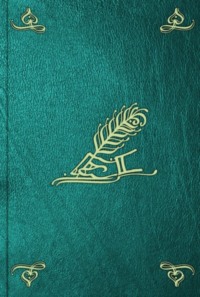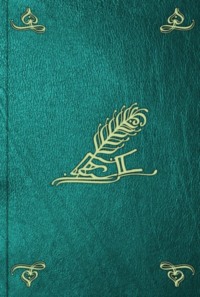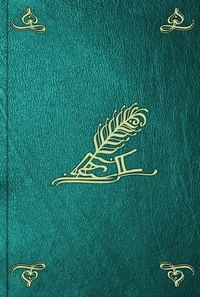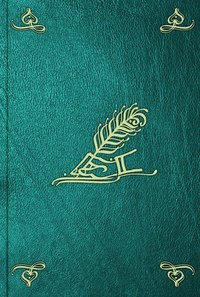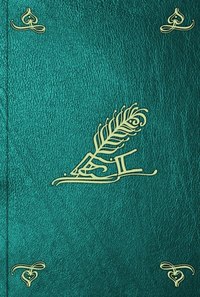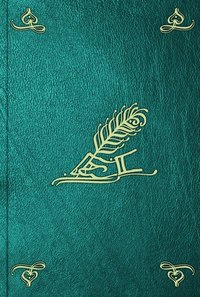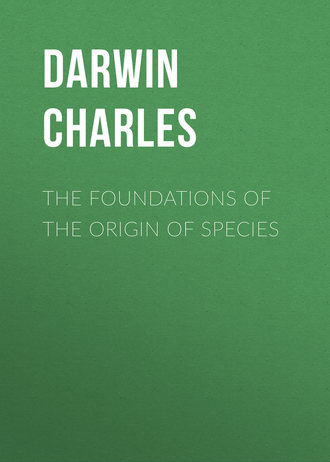 полная версия
полная версияThe Foundations of the Origin of Species
The simple geologist can explain many of the foregoing cases of distribution. Subsidence of a continent in which free means of dispersal, would drive the lowland plants up to the mountains, now converted into islands, and the semi-alpine plants would take place of alpine, and alpine be destroyed, if mountains originally were not of great height. So we may see, during gradual changes126 of climate on a continent, the propagation of species would vary and adapt themselves to small changes causing much extermination127. The mountains of Europe were quite lately covered with ice, and the lowlands probably partaking of the Arctic climate and Fauna. Then as climate changed, arctic fauna would take place of ice, and an inundation of plants from different temperate countries «would» seize the lowlands, leaving islands of arctic forms. But if this had happened on an island, whence could the new forms have come, – here the geologist calls in creationists. If island formed, the geologist will suggest «that» many of the forms might have been borne from nearest land, but if peculiar, he calls in creationist, – as such island rises in height &c., he still more calls in creation. The creationist tells one, on a «illegible» spot the American spirit of creation makes Orpheus and Tyrannus and American doves, and in accordance with past and extinct forms, but no persistent relation between areas and distribution, Geologico-Geograph. – Distribution.
Now according to analogy of domesticated animals let us see what would result. Let us take case of farmer on Pampas, where everything approaches nearer to state of nature. He works on organisms having strong tendency to vary: and he knows «that the» only way to make a distinct breed is to select and separate. It would be useless to separate the best bulls and pair with best cows if their offspring run loose and bred with the other herds, and tendency to reversion not counteracted; he would endeavour therefore to get his cows on islands and then commence his work of selection. If several farmers in different rincons128 were to set to work, especially if with different objects, several breeds would soon be produced. So would it be with horticulturist and so history of every plant shows; the number of varieties129 increase in proportion to care bestowed on their selection and, with crossing plants, separation. Now, according to this analogy, change of external conditions, and isolation either by chance landing «of» a form on an island, or subsidence dividing a continent, or great chain of mountains, and the number of individuals not being numerous will best favour variation and selection130. No doubt change could be effected in same country without any barrier by long continued selection on one species: even in case of a plant not capable of crossing would easier get possession and solely occupy an island131. Now we can at once see that «if» two parts of a continent isolated, new species thus generated in them, would have closest affinities, like cattle in counties of England: if barrier afterwards destroyed one species might destroy the other or both keep their ground. So if island formed near continent, let it be ever so different, that continent would supply inhabitants, and new species (like the old) would be allied with that continent. An island generally very different soil and climate, and number and order of inhabitants supplied by chance, no point so favourable for generation of new species132, – especially the mountains, hence, so it is. As isolated mountains formed in a plain country (if such happens) is an island. As other islands formed, the old species would spread and thus extend and the fauna of distant island might ultimately meet and a continent formed between them. No one doubts continents formed by repeated elevations and depressions133. In looking backwards, but not so far that all geographical boundaries are destroyed, we can thus at once see why existing forms are related to the extinct in the same manner as existing ones are in some part of existing continent. By chance we might even have one or two absolute parent fossils.
The detection of transitional forms would be rendered more difficult on rising point of land.
The distribution therefore in the above enumerated points, even the trivial ones, which on any other «theory?» can be viewed as so many ultimate facts, all follow «in» a simple manner on the theory of the occurrence of species by «illegible» and being adapted by selection to «illegible», conjoined with their power of dispersal, and the steady geographico-geological changes which are now in progress and which undoubtedly have taken place. Ought to state the opinion of the immutability of species and the creation by so many separate acts of will of the Creator134.
§ VII. «Affinities and Classification.»
Looking now to the affinities of organisms, without relation to their distribution, and taking all fossil and recent, we see the degrees of relationship are of different degrees and arbitrary, – sub-genera, – genera, – sub-families, families, orders and classes and kingdoms. The kind of classification which everyone feels is most correct is called the natural system, but no can define this. If we say with Whewell «that we have an» undefined instinct of the importance of organs135, we have no means in lower animals of saying which is most important, and yet everyone feels that some one system alone deserves to be called natural. The true relationship of organisms is brought before one by considering relations of analogy, an otter-like animal amongst mammalia and an otter amongst marsupials. In such cases external resemblance and habit of life and the final end of whole organization very strong, yet no relation136. Naturalists cannot avoid these terms of relation and affinity though they use them metaphorically. If used in simple earnestness the natural system ought to be a genealogical «one»; and our knowledge of the points which are most easily affected in transmission are those which we least value in considering the natural system, and practically when we find they do vary we regard them of less value137. In classifying varieties the same language is used and the same kind of division: here also (in pine-apple)138 we talk of the natural classification, overlooking similarity of the fruits, because whole plant differs. The origin of sub-genera, genera, &c., &c., is not difficult on notion of genealogical succession, and accords with what we know of similar gradations of affinity in domesticated organisms. In the same region the organic beings are «illegible» related to each other and the external conditions in many physical respects are allied139 and their differences of same kind, and therefore when a new species has been selected and has obtained a place in the economy of nature, we may suppose that generally it will tend to extend its range during geographical changes, and thus, becoming isolated and exposed to new conditions, will slightly alter and its structure by selection become slightly remodified, thus we should get species of a sub-genus and genus, – as varieties of merino-sheep, – varieties of British and Indian cattle. Fresh species might go on forming and others become extinct and all might become extinct, and then we should have «an» extinct genus; a case formerly mentioned, of which numerous cases occur in Palæontology. But more often the same advantages which caused the new species to spread and become modified into several species would favour some of the species being preserved: and if two of the species, considerably different, each gave rise to group of new species, you would have two genera; the same thing will go on. We may look at case in other way, looking to future. According to mere chance every existing species may generate another, but if any species, A, in changing gets an advantage and that advantage (whatever it may be, intellect, &c., &c., or some particular structure or constitution) is inherited140, A will be the progenitor of several genera or even families in the hard struggle of nature. A will go on beating out other forms, it might come that A would people earth, – we may now not have one descendant on our globe of the one or several original creations141. External conditions air, earth, water being same142 on globe, and the communication not being perfect, organisms of widely different descent might become adapted to the same end and then we should have cases of analogy143, [they might even tend to become numerically representative]. From this often happening each of the great divisions of nature would have their representative eminently adapted to earth, to «air»144, to water, and to these in «illegible» and then these great divisions would show numerical relations in their classification.
§ VIII. Unity [or similarity] of type in the great classes
Nothing more wonderful in Nat. Hist. than looking at the vast number of organisms, recent and fossil, exposed to the most diverse conditions, living in the most distant climes, and at immensely remote periods, fitted to wholely different ends, yet to find large groups united by a similar type of structure. When we for instance see bat, horse, porpoise-fin, hand, all built on same structure145, having bones146 with same name, we see there is some deep bond of union between them147, to illustrate this is the foundation and objects «?» «of» what is called the Natural System; and which is foundation of distinction «?» of true and adaptive characters148. Now this wonderful fact of hand, hoof, wing, paddle and claw being the same, is at once explicable on the principle of some parent-forms, which might either be «illegible» or walking animals, becoming through infinite number of small selections adapted to various conditions. We know that proportion, size, shape of bones and their accompanying soft parts vary, and hence constant selection would alter, to almost any purpose «?» the framework of an organism, but yet would leave a general, even closest similarity in it.
[We know the number of similar parts, as vertebræ and ribs can vary, hence this also we might expect.] Also «if» the changes carried on to a certain point, doubtless type will be lost, and this is case with Plesiosaurus149. The unity of type in past and present ages of certain great divisions thus undoubtedly receives the simplest explanation.
There is another class of allied and almost identical facts, admitted by the soberest physiologists, [from the study of a certain set of organs in a group of organisms] and refers «? referring» to a unity of type of different organs in the same individual, denominated the science of “Morphology.” The «? this» discovered by beautiful and regular series, and in the case of plants from monstrous changes, that certain organs in an individual are other organs metamorphosed. Thus every botanist considers petals, nectaries, stamens, pistils, germen as metamorphosed leaf. They thus explain, in the most lucid manner, the position and number of all parts of the flower, and the curious conversion under cultivation of one part into another. The complicated double set of jaws and palpi of crustaceans150, and all insects are considered as metamorphosed «limbs» and to see the series is to admit this phraseology. The skulls of the vertebrates are undoubtedly composed of three metamorphosed vertebræ; thus we can understand the strange form of the separate bones which compose the casket holding man’s brain. These151 facts differ but slightly from those of last section, if with wing, paddle, hand and hoof, some common structure was yet visible, or could be made out by a series of occasional monstrous conversions, and if traces could be discovered of «the» whole having once existed as walking or swimming instruments, these organs would be said to be metamorphosed, as it is they are only said to exhibit a common type.
This distinction is not drawn by physiologists, and is only implied by some by their general manner of writing. These facts, though affecting every organic being on the face of the globe, which has existed, or does exist, can only be viewed by the Creationist as ultimate and inexplicable facts. But this unity of type through the individuals of a group, and this metamorphosis of the same organ into other organs, adapted to diverse use, necessarily follows on the theory of descent152. For let us take case of Vertebrata, which if153 they descended from one parent and by this theory all the Vertebrata have been altered by slow degrees, such as we see in domestic animals. We know that proportions alter, and even that occasionally numbers of vertebræ alter, that parts become soldered, that parts are lost, as tail and toes, but we know «that?» here we can see that possibly a walking organ might «?» be converted into swimming or into a gliding organ and so on to a flying organ. But such gradual changes would not alter the unity of type in their descendants, as parts lost and soldered and vertebræ. But we can see that if this carried to extreme, unity lost, – Plesiosaurus. Here we have seen the same organ is formed «?» «for» different purposes «ten words illegible»: and if, in several orders of vertebrata, we could trace origin «of» spinous processes and monstrosities &c. we should say, instead of there existing a unity of type, morphology154, as we do when we trace the head as being the vertebræ metamorphosed. Be it observed that Naturalists, as they use terms of affinity without attaching real meaning, here also they are obliged to use metamorphosis, without meaning that any parent of crustacean was really an animal with as many legs as crustacean has jaws. The theory of descent at once explains these wonderful facts.
Now few of the physiologists who use this language really suppose that the parent of insect with the metamorphosed jaw, was an insect with [more] so many legs, or that the parent of flowering plants, originally had no stamens, or pistils or petals, but some other means of propagation, – and so in other cases. Now according to our theory during the infinite number of changes, we might expect that an organ used for a purpose might be used for a different one by his descendant, as must have been the case by our theory with the bat, porpoise, horse, &c., which are descended from one parent. And if it so chanced that traces of the former use and structure of the part should be retained, which is manifestly possible if not probable, then we should have the organs, on which morphology is founded and which instead of being metaphorical becomes plain and «and instead of being» utterly unintelligible becomes simple matter of fact155.
«Embryology.» This general unity of type in great groups of organisms (including of course these morphological cases) displays itself in a most striking manner in the stages through which the fœtus passes156. In early stage, the wing of bat, hoof, hand, paddle are not to be distinguished. At a still earlier «stage» there is no difference between fish, bird, &c. &c. and mammal. It is not that they cannot be distinguished, but the arteries157 «illegible». It is not true that one passes through the form of a lower group, though no doubt fish more nearly related to fœtal state158.
This similarity at the earliest stage is remarkably shown in the course of the arteries which become greatly altered, as fœtus advances in life and assumes the widely different course and number which characterize full-grown fish and mammals. How wonderful that in egg, in water or air, or in womb of mother, artery159 should run in same course.
Light can be thrown on this by our theory. The structure of each organism is chiefly adapted to the sustension of its life, when full-grown, when it has to feed itself and propagate160. The structure of a kitten is quite in secondary degree adapted to its habits, whilst fed by its mother’s milk and prey. Hence variation in the structure of the full-grown species will chiefly determine the preservation of a species now become ill-suited to its habitat, or rather with a better place opened to it in the economy of Nature. It would not matter to the full-grown cat whether in its young state it was more or less eminently feline, so that it become so when full-grown. No doubt most variation, (not depending on habits of life of individual) depends on early change161 and we must suspect that at whatever time of life the alteration of fœtus is effected, it tends to appear at same period. When we «see» a tendency to particular disease in old age transmitted by the male, we know some effect is produced during conception, on the simple cell of ovule, which will not produce its effect till half a century afterwards and that effect is not visible162. So we see in grey-hound, bull-dog, in race-horse and cart-horse, which have been selected for their form in full-life, there is much less «?» difference in the few first days after birth163, than when full-grown: so in cattle, we see it clearly in cases of cattle, which differ obviously in shape and length of horns. If man were during 10,000 years to be able to select, far more diverse animals from horse or cow, I should expect there would be far less differences in the very young and fœtal state: and this, I think, throws light on above marvellous fact. In larvæ, which have long life selection, perhaps, does much, – in the pupa not so much164 There is no object gained in varying form &c. of fœtus (beyond certain adaptations to mother’s womb) and therefore selection will not further act on it, than in giving to its changing tissues a tendency to certain parts afterwards to assume certain forms.
Thus there is no power to change the course of the arteries, as long as they nourish the fœtus; it is the selection of slight changes which supervene at any time during «illegible» of life.
The less differences of fœtus, – this has obvious meaning on this view: otherwise how strange that a [monkey] horse, a man, a bat should at one time of life have arteries, running in a manner, which is only intelligibly useful in a fish! The natural system being on theory genealogical, we can at once see, why fœtus, retaining traces of the ancestral form, is of the highest value in classification.
§ IX. «Abortive organs.»
There is another grand class of facts relating to what are called abortive organs. These consist of organs which the same reasoning power that shows us how beautifully these organs in some cases are adapted to certain end, declares in other cases are absolutely useless. Thus teeth in Rhinoceros165, whale, narwhal, – bone on tibia, muscles which do not move, – little bone of wing of Apteryx, – bone representing extremities in some snake, – little wings within «?» soldered cover of beetles, – men and bulls, mammæ: filaments without anthers in plants, mere scales representing petals in others, in feather-hyacinth whole flower. Almost infinitely numerous. No one can reflect on these without astonishment, can anything be clearer than that wings are to fly and teeth «to bite», and yet we find these organs perfect in every detail in situations where they cannot possibly be of their normal use166.
The term abortive organ has been thus applied to above structure (as invariable as all other parts167) from their absolute similarity to monstrous cases, where from accident, certain organs are not developed; as infant without arms or fingers with mere stump representing them: teeth represented by mere points of ossification: headless children with mere button, – viscera represented by small amorphous masses, &c., – the tail by mere stump, – a solid horn by minute hanging one168. There is a tendency in all these cases, when life is preserved, for such structures to become hereditary. We see it in tailless dogs and cats. In plants we see this strikingly, – in Thyme, in Linum flavum, – stamen in Geranium pyrenaicum169. Nectaries abort into petals in Columbine «Aquilegia», produced from some accident and then become hereditary, in some cases only when propagated by buds, in other cases by seed. These cases have been produced suddenly by accident in early growth, but it is part of law of growth that when any organ is not used it tends to diminish (duck’s wing170?) muscles of dog’s ears, «and of» rabbits, muscles wither, arteries grow up. When eye born defective, optic nerve (Tuco Tuco) is atrophied. As every part whether useful or not (diseases, double flowers) tends to be transmitted to offspring, the origin of abortive organs whether produced at the birth or slowly acquired is easily understood in domestic races of organisms: [a struggle between the atrophy and hereditariness. Abortive organs in domestic races.] There will always be a struggle between atrophy of an organ rendered useless, and hereditariness171. Because we can understand the origin of abortive organs in certain cases, it would be wrong to conclude absolutely that all must have had same origin, but the strongest analogy is in favour of it. And we can by our theory, for during infinite changes some organ, we might have anticipated, would have become useless. «We can» readily explain the fact, so astounding on any other view, namely that organs possibly useless have been formed often with the same exquisite care as when of vital importance.
Our theory, I may remark would permit an organ «to» become abortive with respect to its primary use, to be turned to any other purpose, (as the buds in a cauliflower) thus we can see no difficulty in bones of male marsupials being used as fulcrum of muscles, or style of marygold172, – indeed in one point of view, the heads of [vertebrated] animal may be said to be abortive vertebræ turned into other use: legs of some crustacea abortive jaws, &c., &c. De Candolle's analogy of table covered with dishes173.
«The following passage was possibly intended to be inserted here.» Degradation and complication see Lamarck: no tendency to perfection: if room, [even] high organism would have greater power in beating lower one, thought «?» to be selected for a degraded end.
§ X. Recapitulation and conclusion
Let us recapitulate the whole «?» «of» these latter sections by taking case of the three species of Rhinoceros, which inhabit Java, Sumatra, and mainland of Malacca or India. We find these three close neighbours, occupants of distinct but neighbouring districts, as a group having a different aspect from the Rhinoceros of Africa, though some of these latter inhabit very similar countries, but others most diverse stations. We find them intimately related [scarcely «?» differences more than some breeds of cattle] in structure to the Rhinoceros, which for immense periods have inhabited this one, out of three main zoological divisions of the world. Yet some of these ancient animals were fitted to very different stations: we find all three «illegible» of the generic character of the Rhinoceros, which form a [piece of net]174 set of links in the broken chain representing the Pachydermata, as the chain likewise forms a portion in other and longer chains. We see this wonderfully in dissecting the coarse leg of all three and finding nearly the same bones as in bat’s wings or man’s hand, but we see the clear mark in solid tibia of the fusion into it of the fibula. In all three we find their heads composed of three altered vertebræ, short neck, same bones as giraffe. In the upper jaws of all three we find small teeth like rabbit’s. In dissecting them in fœtal state we find at a not very early stage their form exactly alike the most different animals, and even with arteries running as in a fish: and this similarity holds when the young one is produced in womb, pond, egg or spawn. Now these three undoubted species scarcely differ more than breeds of cattle, are probably subject to many the same contagious diseases; if domesticated these forms would vary, and they might possibly breed together, and fuse into something175 different «from» their aboriginal forms; might be selected to serve different ends.
Now the Creationist believes these three Rhinoceroses were created176 with their deceptive appearance of true, not «illegible» relationship; as well can I believe the planets revolve in their present courses not from one law of gravity but from distinct volition of Creator.
If real species, sterile one with another, differently adapted, now inhabiting different countries, with different structures and instincts, are admitted to have common descent, we can only legitimately stop where our facts stop. Look how far in some case a chain of species will lead us. «This probably refers to the Crustacea, where the two ends of the series have “hardly a character in common.” Origin, Ed. i. p. 419.» May we not jump (considering how much extermination, and how imperfect geological records) from one sub-genus to another sub-genus. Can genera restrain us; many of the same arguments, which made us give up species, inexorably demand genera and families and orders to fall, and classes tottering. We ought to stop only when clear unity of type, independent of use and adaptation, ceases.



